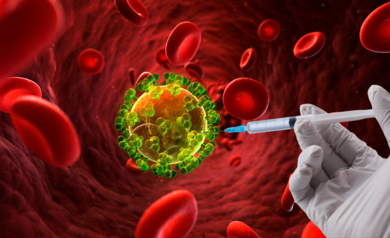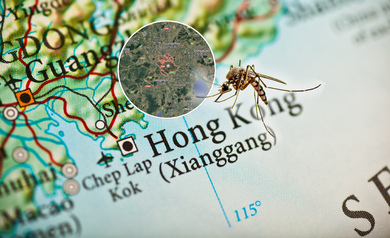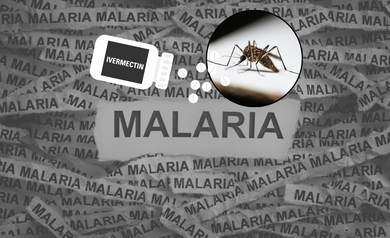- Health Conditions A-Z
- Health & Wellness
- Nutrition
- Fitness
- Health News
- Ayurveda
- Videos
- Medicine A-Z
- Parenting
- Web Stories
Not Just COVID, 1.5 Million More Lives Were Lost After The Pandemic Than Expected

Credits: Canva
As the world collectively exhaled a sigh of relief in 2022, thinking the worst of the COVID-19 pandemic had come and gone, a covert crisis stealthily took hundreds of thousands more lives in America. Rather than rebounding toward pre-pandemic levels, U.S. death rates have remained obstinately elevated, accounting for over 1.5 million "missing Americans" during 2022 and 2023—fatalities that could potentially have been avoided if our country had been comparable to other affluent nations on health outcomes. This quiet excess wave of mortality reveals deeply ingrained national shortcomings well beyond the range of any given infectious illness.
Scientists from Boston University and the University of Minnesota analyzed U.S. official death records and those from 21 other high-income countries—Australia, Canada, France, Japan, the United Kingdom, and others—over 43 years from 1980 to 2023. During that period, the U.S. incurred almost 15 million excess deaths against peer nations, which means Americans died at rates much higher than what would be predicted if we followed their lower death trends.
In 1980, the U.S. actually performed better than its contemporaries, saving approximately 42,000 lives. By 1990, it had chalked up about 89,000 excess deaths. The count rose to 355,000 in 2000 and 409,000 in 2010. At the peak of the pandemic, excess deaths ballooned to 1 million in 2020 and 1.1 million in 2021. Even as COVID-19 declined, the U.S. lost 820,000 excess lives in 2022 and 705,000 in 2023.
This long-term trend indicates not a fleeting anomaly but a prolonged public health crisis. "Imagine the lives saved, the grief and trauma prevented, if the U.S. simply performed at the average of our peers," says lead author Jacob Bor, associate professor of Boston University's School of Public Health. "One in every two U.S. deaths before age 65 is probably preventable. Our failure to do something about it is a national scandal.
Are People Under-65 at Higher Risk?
Perhaps the most alarming finding is that in 2023, nearly 46% of deaths among Americans under 65 could have been prevented were our mortality rates on par with other high-income nations. In a country that prides itself on medical innovation and economic prowess, young and middle-aged adults are dying from conditions that, elsewhere, are managed far more effectively.
An important proportion of these deaths are motivated by deep-seated noncommunicable and social-environmental causes: drug overdoses, firearms violence, motor vehicle crashes, and avoidable cardiometabolic disease. "These trends preceded the pandemic and went unstopped thereafter," says University of Minnesota's Elizabeth Wrigley-Field. "The 700,000 surplus American deaths in 2023 are precisely what you'd expect from previously increasing trends, even if there'd never been a pandemic."
What Is Reason Behind This Excess Mortality?
1. Substance Use and Overdose
The American overdose epidemic, driven by opioids, methamphetamine, and increasingly by powerful synthetic opioids such as fentanyl, continues to be a major cause of premature mortality. Whereas peer countries have introduced harm-reduction policies—expanded naloxone distribution, supervised injection sites—the United States has grappled with adopting these data-driven policies at scale.
2. Violence and Injury
Homicide and gun-related fatalities have exploded in recent decades. Other rich nations, however, have witnessed declines in violent crime and road traffic deaths due to draconian gun-control policies, safer car regulations, and vigorous road-safety campaigns.
3. Cardiometabolic Disease
Heart disease, diabetes, and obesity are responsible for a significant proportion of preventable deaths. Compounding factors—disproportionate access to medical care, food deserts, and socioeconomic inequalities—exacerbate these conditions among vulnerable groups.
Why the U.S. Lags Behind?
Senior researcher Andrew Stokes refers to the stark policy distinctions: "Other nations demonstrate that investing in universal health care, robust safety nets, and evidence-based public health policies results in longer, healthier lives." The U.S., however, has:
Fragmented Healthcare: Close to 30 million Americans lack insurance, and millions more underinsured, with obstacles to preventive health care and management of chronic diseases.
Weak Social Safety Nets: Family pay leave, unemployment benefits, and poverty assistance in the United States are far behind those in Europe, Canada, and Australia.
Political Polarization: Government distrust and partisan gridlock have interfered with coordinated actions to deal with health crises, ranging from overdose response to pandemic readiness.
Even worse, the planned federal reductions to Medicare, Medicaid, and public health funding could further expand the gap. The recently House-approved legislation, as part of a possible second Trump administration agenda, would contract health programs at the very time that strong support is needed more than ever. "Severe reductions to public health, safety net programs, and federal health data could result in a further expansion of health disparities—and increasing numbers of excess—and entirely preventable—deaths," warns Bor.
Reversing America's Excess Death Crisis
In spite of the grim fact of excess mortality in America, solutions are not new nor out of reach. Other nations, such as Canada, the U.K., and France, have shown that universal healthcare, be it through single-payer or hybrid models, can provide near-universal coverage for primary and preventive care. This kind of complete coverage greatly reduces deaths from treatable causes, which serves as a reminder of the value in a system emphasizing early intervention over crisis management.
Equally, harm reduction strategies have been strikingly effective in nations like Australia and a number of European countries. In these nations, there has been increased access to addiction treatment, overdose reversal medicines with lifesaving properties, and safe-use centers, which have worked together to decrease overdose death in a noticeable manner. These initiatives are a realistic and humane response to drug use, centering on reducing harm and supporting recovery over punitive policies.
Prevention of injury and violence deaths is yet another critical element. Seat-belt laws, graduated licensing of teenage drivers, and strict gun control have been shown to prevent car accident fatalities and violence caused by guns. These evidence-based and public safety policies provide a clear plan to mitigate avoidable deaths in the United States.
But applying these solutions at home will take political will, institutional capacity, and societal consensus. The cost of not acting has already been staggering more than 1.5 million excess deaths in the last two years alone. If the U.S. keeps on its present course, the numbers could go even higher.
To turn around this trend, America needs to spend significantly on public health infrastructure. Disease surveillance should be made stronger, data need to be made more transparent, and community health centers should be extended to cover more areas in order to build a more resilient healthcare system. These initiatives not only will ready the country for crises ahead but also improve daily health outcomes.
Increasing access to care is also paramount. Progress toward universal coverage—or at least the removal of financial obstacles that keep individuals from accessing timely preventive and primary care—could have an enormous impact on decreasing early death. Healthcare access should be a right tied neither to employment nor income but to basic human needs.
In addition, adopting evidence-based policies must become the standard rather than the exception. Harm reduction, injury prevention, and targeted interventions for chronic illnesses like heart disease and diabetes must be prioritized. These are not radical ideas; they are proven strategies with measurable success rates in comparable countries.
As Bor insists, “We have the tools and the knowledge. What we lack is the collective resolve to act.”
The 1.5 million lives lost in 2022 and 2023 are not mere statistics—they are mothers, fathers, siblings, and friends whose deaths were avoidable. While the pandemic was a tragic catalyst, the underlying causes of excess mortality run much deeper than any single virus. Confronting this crisis requires acknowledging that America’s health system and social policies have long failed to protect large swaths of its population.
Ultimately, catching up to, or exceeding, the health achievements of our peer nations is not only a matter of national pride or global reputation. It is a moral obligation, requiring us to deploy science, policy, and empathy to ensure that the next generation of Americans lives longer, healthier lives.
EU Approves 'Twice Yearly' Injectable HIV Drug To Fight The Virus And Stop Transmission

Credits: Canva
The European Medicines Agency (EMA) has taken a bold step forward in the fight against HIV. On Friday, it recommended the authorization of lenacapavir — an injectable drug shown to be almost 100% effective in preventing HIV transmission. Marketed as Yeytuo in Europe by California-based Gilead Sciences, this drug stands out for its convenience and duration: just two injections per year could prevent infection.
This recommendation is more than just another drug approval. It represents a powerful new tool in a decades-long battle against HIV, one that could fundamentally change how we think about prevention — if access can keep up with innovation.
Once the European Commission rubber-stamps the EMA’s guidance, Yeytuo will be authorized across all 27 EU member states, plus Iceland, Norway, and Liechtenstein. The decision marks a milestone in public health strategy, particularly for populations that face social and logistical barriers to current HIV prevention options.
Unlike existing daily pills or bimonthly injections like cabotegravir, lenacapavir requires just two injections a year. That’s a huge leap in terms of convenience and adherence — and a potential game-changer for people who can’t or won’t take a daily pill due to stigma, forgetfulness, or limited access to healthcare.
The data behind it is strong. In a landmark trial involving nearly 5,000 young women and girls in South Africa and Uganda, not a single participant who received the injection contracted HIV. In contrast, about 2% of those who took daily pills still became infected. The study’s results, published in the New England Journal of Medicine and presented at an AIDS conference in Munich, were so convincing that researchers ended it early to offer lenacapavir to all participants.
“This level of protection is stunning,” said Dr. Salim Abdool Karim, a renowned AIDS researcher based in Durban, South Africa, who was not involved in the study.
The drug is already approved in the U.S., Canada, and Europe as a treatment for HIV. Now, its preventive potential is gaining traction, fast.
More than 40 million people live with HIV globally, and around 630,000 people died from AIDS-related illnesses in 2023 alone, according to UNAIDS. The burden is heaviest in sub-Saharan Africa, Southeast Asia, and the Caribbean — regions that urgently need new prevention tools.
Recognizing this, the World Health Organization (WHO) recently recommended that countries adopt lenacapavir as an additional HIV prevention option, not a replacement. It would complement existing methods like condoms, PrEP pills, and cabotegravir injections.
Winnie Byanyima, Executive Director of UNAIDS, has called lenacapavir “a drug that could change the trajectory of the HIV epidemic,” stressing that equitable access will be key to its success and therein lies the problem.
While Gilead has pledged to allow generic production in 120 low-income countries, it has excluded nearly all of Latin America, where HIV rates remain relatively low but are steadily rising. Critics argue that leaving these regions behind could create new blind spots in the global prevention map — and miss a crucial chance to curb the virus early.
Gilead has defended its access strategy, noting that it's focused on countries with the highest burden. But public health experts warn that rising infections in lower-prevalence regions should not be ignored.
“Ending HIV isn’t just about treating the hardest-hit places. It’s about staying ahead of new outbreaks,” said one international HIV policy advisor who requested anonymity.
Even in countries where the drug may be approved, cost, supply, and health system capacity could hinder rollout — especially in rural or underserved areas. Stigma also remains a significant barrier, deterring many at-risk individuals from seeking preventive care.
Now that the EMA has endorsed lenacapavir for prevention, the European Commission is expected to follow suit, likely within weeks. Approval there would greenlight its use in countries representing nearly half a billion people.
Meanwhile, the U.S. Food and Drug Administration (FDA) approved lenacapavir for prevention earlier this year, and the WHO’s recommendation is expected to guide policies globally but the question remains: will this groundbreaking injectable be made available to the people who need it most — when they need it most?
UNAIDS and other public health advocates are urging a broader global licensing strategy to ensure equitable access. Some have called on leaders — including former President Donald Trump during his term — to broker deals that would fast-track generic production and distribution worldwide.
Lenacapavir’s development is undeniably a breakthrough — scientifically, medically, and logistically. Its six-month dosing schedule reduces clinic visits, lowers the burden of adherence, and offers privacy for people facing stigma. For many, it could be the most realistic prevention option yet but if it remains limited to wealthy countries or a select list of high-burden nations, it won’t fulfill its potential to shift the course of the epidemic. It could become another case study in medical innovation outpacing policy.
With Over 3,100 Infected, Deadly Mosquito-Borne Virus Spreads Rapidly In China—Is It Climate, Travel, Or Both?

Credits: Canva
Foshan city in Guangdong Province is experiencing the country’s largest outbreak of chikungunya, a mosquito-borne viral disease that causes debilitating joint pain, fever, and fatigue. As of July 24, 2025, 3,645 cases have been confirmed—most of them mild, but alarming due to the rapid spread and potential for further outbreaks in surrounding regions.
This surge represents the most significant chikungunya transmission on the Chinese mainland since the virus was first detected there nearly two decades ago.
The epidemic began with an imported case of chikungunya in early July in Shunde District of Foshan, which is roughly 119 kilometers north of Hong Kong. Within weeks, cases ballooned to more than 3,300 in Shunde alone. Chinese officials have not officially attributed the cause, but experts cite favorable climatic conditions—hot and humid that facilitate mosquito breeding—and increased global travel as main drivers.
Chikungunya is transmitted by the Aedes mosquito, most specifically Aedes aegypti and Aedes albopictus. Both insects are famous for their daytime aggression of biting and love for tropical and subtropical regions.
Why Chikungunya Is No Minor Illness Even After All These Years?
The World Health Organization (WHO) defines chikungunya as a disease that is marked by severe joint pain, high fever, and signs and symptoms of headache, muscle pain, rash, vomiting, and fatigue. Though the majority of Foshan cases have been reported as mild, the disabling joint pain of the disease may persist for weeks or even months and can affect daily activities and productivity.
While not usually lethal, chikungunya has the potential to create large-scale public health disturbances, particularly in highly congested urban areas with inadequate mosquito control. To date, no serious or deadly cases have been reported in this outbreak, as indicated by China's Centre for Health Protection (CHP), but public health specialists caution against taking the situation lightly.
How Climate and Travel Are Driving This Outbreak?
Specialized tropical medicine doctors attribute the peak to favorable climatic conditions that promote quick growth of Aedes populations. These are aggressive, day-biting mosquitoes that thrive in warm, wet conditions, noting how climate change plays a major role in expanding habitats for mosquitoes.
Combine this international travel—imported and first case—and lack of immunity in the general population in China, and the stage was set for an outbreak. Chikungunya is not indigenous to China, so there is no herd immunity in the general population, and it was easier for the virus to establish itself and spread rapidly.
Link Between Chikungunya Cases on the Rise Globally
This outbreak is not unique. The European Centre for Disease Prevention and Control (ECDC) has reported 220,000 cases of chikungunya and 80 deaths in 2025 thus far worldwide. The WHO has made a global call to action citing the spread of chikungunya into new regions such as France and Italy, which have each reported locally-acquired infections in 2025.
Over five billion individuals in 119 countries reside in regions exposed to chikungunya infection and thus is considered a global health issue. The tropical diseases of chikungunya, dengue, and Zika are no longer limited to the equatorial belt-they are now reported from temperate regions as well.
To date, Hong Kong—a highly populated international center—has not seen any chikungunya cases after 2020. The territory is not home to Aedes aegypti, the main vector mosquito, but Aedes albopictus, a secondary vector known to spread the disease, is found there. The CHP cautions that imported cases still have the potential to result in local transmission if infected persons are bitten by mosquitoes within their communicable period.
Macao, just south of Guangdong, has registered its first two cases of chikungunya this year, both of them imported from Foshan and nearby Nanhai. Local authorities have stepped up mosquito control as a precaution against possible spread.
How Is China Managing The Outbreak?
With not much else in its bag of tricks, Guangdong Province has increased mosquito control operations, encouraging residents to clear standing water, unblock choked drains, and observe simple household sanitation. This is essential in interrupting the mosquito life cycle because still water provides a breeding ground for Aedes mosquitoes.
The CHP also recommends applying insect repellents, especially containing DEET or other WHO-recommended active compounds, and wearing long-sleeved clothing, especially in the early morning and late afternoon when mosquitoes are most prevalent.
The United States has only two licensed chikungunya vaccines, recommended mainly for visitors going to outbreak areas. However, China also doesn't have these vaccines available, which makes its citizens susceptible to successive waves unless mass vaccination is implemented or localized vaccines are created.
This leaves health authorities with few options: mosquito control, public awareness, and early diagnosis remain the main line of defense for the time being.
This epidemic is a clear message. Diseases such as chikungunya no longer remain isolated in small enclaves of tropical countries. With the climate still rising and international travel recovering after the pandemic, infectious disease is set to travel quicker and more far-reaching than ever before.
Dr. Tsui, a Guangdong public health official, explained in a press statement that chikungunya has the potential to quickly blow into large-scale outbreaks, particularly in highly populated regions with low mosquito densities and little immunity. The burden on healthcare systems, particularly in fast-growing urban areas of Asia, is a legitimate and increasing concern.
Ivermectin Proven To Cut Malaria Cases By 26%, Study Finds—Here’s How It Works

Credits: Canva
A new study published in the New England Journal of Medicine has delivered a striking insight into the global fight against malaria. Ivermectin—a widely used antiparasitic drug—has been shown to reduce malaria incidence by 26% in a large-scale trial conducted in Kenya. While ivermectin’s role in treating diseases like river blindness and elephantiasis is well-known, its impact on malaria prevention opens the door to a new, complementary strategy in high-risk regions. The finding is especially significant as malaria control efforts face stagnation due to growing resistance to traditional tools like insecticide-treated nets.
Malaria remains one of the deadliest diseases globally, with nearly 600,000 deaths and over 260 million cases reported in 2023 alone. Africa accounts for the vast majority of these cases, where bed nets and indoor spraying have long been the frontline defense. But here’s the problem: mosquitoes are adapting. Insecticide resistance is on the rise, and some species have shifted behavior, biting outdoors or at times when nets offer no protection.
The need for an alternative, preferably one that can work alongside existing tools, is urgent. Enter ivermectin.
How Ivermectin Works Against Malaria?
Ivermectin doesn’t target the malaria parasite itself. Instead, it turns humans into mosquito killers.
Here’s how: when a person takes ivermectin, the drug circulates in their bloodstream for several days. If a mosquito bites that person during that window, the drug is toxic to the mosquito. This reduces the mosquito population and, by extension, cuts malaria transmission.
This “endectocide” approach—targeting parasites both inside and outside the body—adds an entirely different layer to malaria control.
The BOHEMIA (Broad One Health Endectocide-based Malaria Intervention in Africa) trial is the largest study to date exploring ivermectin’s impact on malaria. Led by the Barcelona Institute for Global Health (ISGlobal), the study took place in Kwale County, a malaria-endemic region of coastal Kenya where the use of insecticide-treated bed nets is already high. Here’s what the researchers did:
84 clusters of households were randomly assigned to receive either ivermectin or a control drug (albendazole).
Participants (nearly 29,000 people in total) were given their respective drugs once a month for three months during the region’s rainy season, when malaria transmission spikes.
Researchers then tracked malaria infection rates specifically in children aged 5 to 15, testing them monthly for six months.
Children in the ivermectin group had 2.20 malaria infections per child-year, compared to 2.66 in the control group—a 26% relative reduction.
What stood out in the findings was the gradient effect—the farther a child lived from the border of the study clusters, the stronger the protection. This points to a community-wide benefit, not just an individual one. In simpler terms, the more people around you who take ivermectin, the less likely you are to get malaria.
The protective effect also met and surpassed the World Health Organization’s minimum efficacy threshold, which recommends at least a 20% reduction in infection lasting one month after treatment.
Dr. Carlos Chaccour, co-principal investigator of the study, called the results “thrilling,” adding that ivermectin “could complement existing control measures.” His colleague, Dr. Regina Rabinovich, emphasized the drug’s potential in areas where traditional tools are beginning to fail.
Safety is always a sticking point with mass drug administration. But in this trial, ivermectin had a favorable safety profile, consistent with its use in other public health campaigns against neglected tropical diseases.
No serious drug-related adverse events were reported. The few side effects that did appear—such as dizziness or nausea—were mild and short-lived.
This is crucial because any tool proposed for broad-scale use, especially in children, must not only be effective but also safe.
Where Does This Leave Us With Malaria Treatment?
In an accompanying editorial, US-based malaria experts have praised the study as “well-conducted” and “not unexpected.” Noting that ivermectin has long shown potential but hadn’t been tested at this scale until now. He also raised a practical point—future studies may explore longer-acting formulations or more frequent dosing, although delivering such strategies at scale could be challenging.
But he also sounded a sobering note: funding for malaria control programs is being slashed across the globe, including Africa, Asia, and the Americas. Without renewed investment, progress could stall—or worse, reverse.
The study results have already been reviewed by the World Health Organization’s Vector Control Advisory Group, which acknowledged the impact and called for additional studies. National health authorities in Kenya and elsewhere are now considering whether to include ivermectin in their malaria control toolkits.
The BOHEMIA team also hopes this will trigger more large-scale research to evaluate the most effective dosing schedules, combination strategies, and delivery methods.
Ivermectin is not a replacement for bed nets or other established tools but it adds a much-needed weapon to the malaria arsenal, especially in regions where mosquitoes are outsmarting traditional methods.
This trial shows us that with the right strategy, an old drug can offer a new solution to one of the world’s deadliest diseases. As malaria continues to evolve, so must our response. Ivermectin might just be the unexpected ally the global health community needs to push the fight forward.
© 2024 Bennett, Coleman & Company Limited

